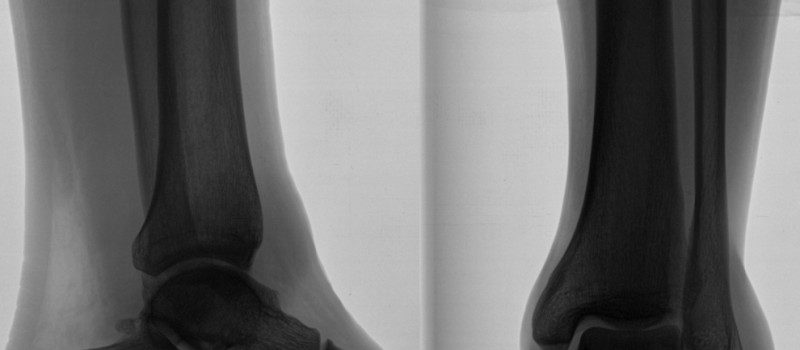
The Dreaded “High Ankle Sprain”
When our Edmonton Oilers young gun Taylor Hall went down with a high ankle sprain, I was asked by many patients why he was out for the season. Were the Oilers medical staff just being protective of Taylor Hall or was it really a serious injury. Let’s take this opportunity to understand what the injury is, how long it takes to recover and what the various stages Taylor Hall’s recovery entailed.
What is a high ankle sprain?
Unlike other ankle sprains, this injury is sustained to the tissue (ligaments) that connect the tibia and the fibula. These are the bones that make up the lower leg (the inner bone being the tibia or shin and the outer being the fibula).
With common ankle sprains “low ankle sprains” the ligaments that are most often injured are the ones on the outside of the ankle. These help to connect the fibula to the foot. These ligaments are injured when someone “rolls” their ankle over. Generally, recovery occurs over a period of 4 to 6 weeks. Most of us have sprained our ankle in this manner and as the swelling goes away, so does the pain. This isn’t to say that these ankle sprains aren’t serious, but in the majority of instances they resolve uneventfully – or at least we feel that they have.
In the high ankle sprain, there are several structures potentially damaged. These include ligaments that connect the tibia to the fibula known as the tibfib ligaments, as well as a tissue called the interosseous membrane. The severity of this injury often depends on how many of these structures are damaged. The recovery time frame varies from 8 weeks to 6 months and this is why the high ankle sprain is so dreaded.
What are the symptoms of a high ankle sprain?
With a high ankle sprain there is often a minimum degree of swelling but unfortunately there tends to be more and longer lasting pain. The pain that occurs with this type of sprain will usually occur when the ankle is turned outward and will be noticed above the ankle. This tendency and the fact that the ligaments are above the ankle lead to the term “high ankle sprain.” Most athletes are diagnosed with these injuries when their ankle sprain takes longer to recover than usual. Clinical diagnosis is based on pain location, palpation, observation and a test known as the “squeeze test.” In Taylor Hall’s case, an MRI would have clearly identified the injured ligament/s, but x-rays by a physician can also play a roll in diagnosis.
How does one get a high ankle sprain?
The common mechanism of injury is sport and most often they occur during forceful twisting outward of the ankle. This injury is more common in football, hockey, wrestling and soccer. In these sports the opportunity to become tangled under another person is increased. The outward twisting motion of the ankle will cause the two bones to pull away from one another and tear the ligaments that connect them.
tear the ligaments that connect them.
Another way to injure these ligaments is via hyperdorsiflexion – which means that the toes are forced toward the shin beyond their normal range. This will occur when an athlete has his foot planted and falls or is pushed forward. In either event the splaying (pulling apart) of the two bones causes the ligaments to tear.
How is a high ankle sprain treated?
- When identified early a stable high ankle sprain is treated with a cast or roho boot for the first 6 weeks. Once the cast is removed, the real tough part of the recovery begins. At this point, due to the immobilization, the joints from the ankle to the toes are very stiff. The physiotherapy is key to restore the lost motion, strength, balance and of course to teach the athlete how to walk and run properly again.
- If missed, the immobilization is usually absent and the ankle sprain is treated very similar to other sprains, but with a lot more patience, plenty of rehabilitation and there is often a need for more caution on return to sport. This caution is necessary because of the possibility of ongoing instability.
- If the sprain is determined to be unstable, the bones of the lower leg require surgical stabilization usually via a screw. I will leave this procedure to the blogs of orthopedic surgeons.
Final thoughts on ankle sprains in general:
In my practice I hear from people that they “always sprain their ankle” or that it’s “just a sprain.” I must make a point that the time to deal with any ankle injury is immediately! There are many degrees of ankle sprain and as you have now read, many different types of ankle sprain. Determining the injury type and severity will go a long way to ensure that your ankle recovers properly. As well, just because the swelling is going away and the pain decreases, this does not imply that the ankle has healed properly. Loss of range of motion, scar tissue and persistent instability are all complications of ankle sprains – even minor ones.
Taylor Hall was in good hands and I am pretty certain that Taylor Hall wouldn’t have said: eh, its just a sprain, I’ll worry about it later. Why would you?
Grant Fedoruk

I’ve had the misfortune to sprain both ankles: higher-ankle in the left; lower in the right. I sprained my higher left ankle in mid December 2013, it still caused me problems in mid May 2014. It’s now late June and I feel like it’s completely ok now (still waiting for my right ankle sprain to heal, ever since April) but it’s tricked me before….
I would definitely recommend taking supplements (Glucosamine combined with Chondroitin worked best for me), eating plenty of protein and vegetables, avoiding peanut products (inflammatory) and easing gently back in the sport you injured it in so you rebuild your strength and flexibility again before you attempt to carry on as normal
Since I was 6 years old I have had “bad ankles”. I have rolled/twisted/and sprained them many times.
Two days ago, I was playing on my new basketball court and the ball rolled away. We had just planted grass seed and my dad had told me not to step on it, so I jumped. I landed on my left ankle with my foot rolled inward. It made a popping noise and I fell to the ground.
Today, it is swollen a little (same as it has been the past two days). I feel like it hurts way worse than it looks. Up and down movements don’t hurt extensively but left and right is PAINFUL!
On the outside of my left ankle, you know that protruding bone? If you touch the bottom/front of that at all it hurts a ton and it’s black and blue there.
Is it sprained? Broken? And what should I do?
I was a college/post/semi-pro women’s player in soccer. I must have twisted my ankle(s) at least once a season, both sides. I HIGHLY agree with the writer who says: don’t underestimate a sprain…
I’m now 50+ and am unable to jog/run/play soccer. I have undergone most everything: injections of many kinds, finally utilizing new treatments in Cayman Island and Colorado clinic with REGENEXX, Centeno-Schultz Clinic. I now am mostly pain free and have returned to decent quality of life. Yet limited in sport.
However, if I had listened to logic: treat the ankle, do the work to re-strengthen, and slowly return, I’m sure I’d be much better off… Just thoughts from someone who was once a committed, all around athlete and is now limited because of my earlier-returning-to-sport-plan…
Good job here. I have really gained a lot in your write up. But I’ve got an ankle sprain since september 2013 while on the pitch. And up till now I still fill pain and its swollen already. Can I still be able to play ball? I am a very good footballer and I don’t want this to end my carear. Thank you so much.
???? ???